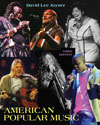Listening Guide 3.1 Listening Guide 3.2 Listening Guide 3.3 Listening Guide 3.1
"Arwhoolie" free rhythm, no meter iTune link = Arwhoolie ELAPSED TIME | FORM | EVENT DESCRIPTION | | :00 | Chorus 1 | High, wordless call | | :07 | Verse 1 | "I won't be here no more" | | :12 | Chorus 2 | Repeat and elongation of call | | :20 | Verse 2 | "I gonna catch me hell" | | :28 | Chorus 3 | Repeat and further elongation of call | | :41 | End | Harmonized vocal (24 measures, no rhythm break this time, + 2 measure call-and-response chant) |
Analysis of "Arwhoolie" Field Recordings, Vol. 3: Mississippi (1936-1942) This is a field recording by folklorist Alan Lomax, made for the Library of Congress. The performer is Thomas J. Marshall, who demonstrated a "field holler." The title is probably derived from the sound of a holler or call. This song has no rhythm or pulse to it, indicating the kind of work it accompanies, such as plowing.
The makeup of the song is most likely extemporaneous and free-flowing, though it does have a form of sorts. It alternates between a wordless call and a short word phrase, a chorus and verse, if you will. In the context of work, the song could go on for quite a while, as the worker sings verses on whatever comes to mind and he or she sings to pass the time. However, the performance is not static. Notice that each time the chorus/call returns, it is elongated, more elaborate, and more intense. Listening Guide 3.2
"Hammer Ring" two beats per measure iTune link = Hammer Ring ELAPSED TIME | FORM | EVENT DESCRIPTION | :00 | Stanza 1 | Melody is relatively flat, on one note | :17 | Stanza 2 | Melody moves to higher pitch, longer string of lines from leader | :44 | Stanza 3 | Similar treatment, backs off a bit in intensity | 1:07 | Stanza 4 | | 1:35 | Stanza 5 | Intensifies, whoops and hollers interject | 1:57 | Stanza 6 | Similar intensity | 2:25 | Stanza 7 | Similar, recording gradually fades out | 2:40 | End | |
Analysis of "Hammer Ring" Field Recordings, Vol. 6: Texas (1933-1958) This is also a field recording by folklorist Alan Lomax, made for the Library of Congress. The performer is Jesse Bradley and a group, who demonstrated a "work song." The title is probably derived from the sound of a holler or call. This song has a strong rhythm or pulse generated by a synchronized task such as chopping trees with an ax or driving railroad spikes. The call and response between a single leader and a chorus of workers also indicate that the song, like the work, is a group effort.
The leader begins by singing the phrase "ring ol' hammer," answered by the group with "hammer ring." They continue to answer the leader with this phrase as he begins to improvise short new phrases. The leader begins each section of the song by returning to the line "ring ol' hammer." I'll call these sections "stanzas." Once again, notice that the music is repetitive, but not static. As we move through the performance, the group becomes more excited and intense, the pitch of the melody move higher, the men shout more, and even begin to whoop and holler between the lines. This is not makes for good music, but shows the energizing and pain-relieving effect of singing while they work. Listening Guide 3.3
"Kneebone" two beats per measure iTune link = Knee Bone ELAPSED TIME | FORM | EVENT DESCRIPTION | :00 | Stanza 1 | Armstrong call to the men, they respond. Handclapping enters after the first phrase | :33 | Stanza 2 | Armstrong uses "bend my knee bone.." twice | 1:04 | Stanza 3 | Similar treatment | 1:42 | Stanza 4 | Rhythm is interrupted when the clappers think the song is over | 2:07 | End | |
Analysis of "Kneebone" The Alan Lomax Collection: Southern Journey, Vol. 13 This is also a field recording by folklorist Alan Lomax, recorded in an isolated black enclave in the sea islands off the coast of Georgia. The performer is Joe Armstrong and a group of men, who demonstrated a religious chant. It is similar to a work song in that a leader sings phrases, while the group echoes back a fixed response.
The most remarkable feature of this performance is the African roots of the rhythm clapped out by the men. The underlying meter is duple, but at least one of the men claps a triple-meter pattern over it. The musical term for this superimposition of triple and duple meter is hemiola. This rhythm is prevalent in most African-based music, including jazz and Latin music. Black composer James P. Johnson approximated this rhythm for his famous song "The Charleston."
Aside from the rhythm is the form of the call-and-response. Armstrong sings an antecedent line, the group responds with a melody on a high note ("Oh, Knee Bone"), then he sings his own consequent line, followed by a descending line from the group ("Oh, Oh, Knee Bone bend"). I chose to mark the beginning of each stanza whenever Armstrong returns to the lines "Knee bone in the morning" or "bend my knee bone to the ground," though you may find other ways to mark the seams in the cycle. |



 2009 McGraw-Hill Higher Education
2009 McGraw-Hill Higher Education